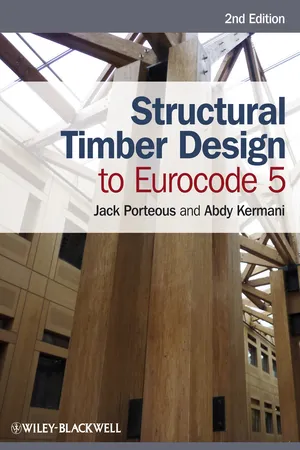
- English
- ePUB (mobile friendly)
- Available on iOS & Android
Structural Timber Design to Eurocode 5
About this book
Structural Timber Design to Eurocode 5 provides practising engineers and specialist contractors with comprehensive, detailed information and in-depth guidance on the design of timber structures based on the common rules and rules for buildings in Eurocode 5 – Part 1-1. It will also be of interest to undergraduate and postgraduate students of civil and structural engineering.
It provides a step-by-step approach to the design of all of the commonly used timber elements and connections using solid timber, glued laminated timber or wood based structural products, and incorporates the requirements of the UK National Annex. It covers:
- strength and stiffness properties of timber and its reconstituted and engineered products
- key requirements of Eurocode 0, Eurocode 1 and Eurocode 5 – Part 1-1
- design of beams and columns of solid timber, glued laminated, composite and thin-webbed sections
- lateral stability requirements of timber structures
- design of mechanical connections subjected to lateral and/or axial forces
- design of moment resisting rigid and semi-rigid connections
- racking design of multi-storey platform framed walls
Featuring numerous detailed worked examples, the second edition has been thoroughly updated and includes information on the consequences of amendments and revisions to EC5 published since the first edition, and the significant additional requirements of BSI non contradictory, complimentary information document (PD 6693-1-1) relating to EC5. The new edition also includes a new section on axial stress conditions in composite sections, covering combined axial and bending stress conditions and reference to the major revisions to the design procedure for glued laminated timber.
Frequently asked questions
- Essential is ideal for learners and professionals who enjoy exploring a wide range of subjects. Access the Essential Library with 800,000+ trusted titles and best-sellers across business, personal growth, and the humanities. Includes unlimited reading time and Standard Read Aloud voice.
- Complete: Perfect for advanced learners and researchers needing full, unrestricted access. Unlock 1.4M+ books across hundreds of subjects, including academic and specialized titles. The Complete Plan also includes advanced features like Premium Read Aloud and Research Assistant.
Please note we cannot support devices running on iOS 13 and Android 7 or earlier. Learn more about using the app.
Information
Chapter 1
Timber as a Structural Material
1.1 INTRODUCTION

1.2 THE STRUCTURE OF TIMBER
1.3 TYPES OF TIMBER
1.3.1 Softwoods
Table of contents
- Cover
- Dedication
- Title page
- Copyright page
- Preface to the Second Edition
- Chapter 1: Timber as a Structural Material
- Chapter 2: Introduction to Relevant Eurocodes
- Chapter 3: Using Mathcad® for Design Calculations
- Chapter 4: Design of Members Subjected to Flexure
- Chapter 5: Design of Members and Walls Subjected to Axial or Combined Axial and Flexural Actions
- Chapter 6: Design of Glued-Laminated Members
- Chapter 7: Design of Composite Timber and Wood-Based Sections
- Chapter 8: Design of Built-Up Columns
- Chapter 9: Design of Stability Bracing, Floor and Wall Diaphragms
- Chapter 10: Design of Metal Dowel-type Connections
- Chapter 11: Design of Joints with Connectors
- Chapter 12: Moment Capacity of Connections Formed with Metal Dowel Fasteners or Connectors
- Chapter 13: Racking Design of Multi-storey Platform Framed Wall Construction
- Appendix A: Weights of Building Materials
- Appendix B: Related British Standards for Timber Engineering in Buildings
- Appendix C: Possible Revisions to be Addressed in a Corrigendum to EN 1995-1-1:2004 + A1:2008
- Index
- The Example Worksheets Order Form